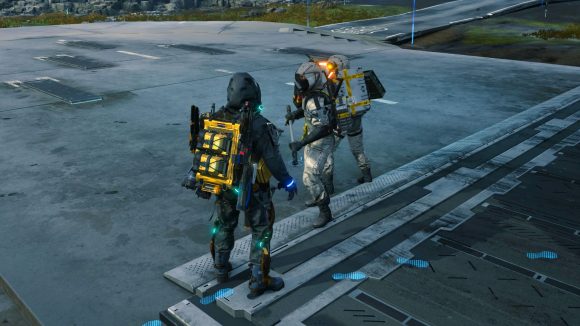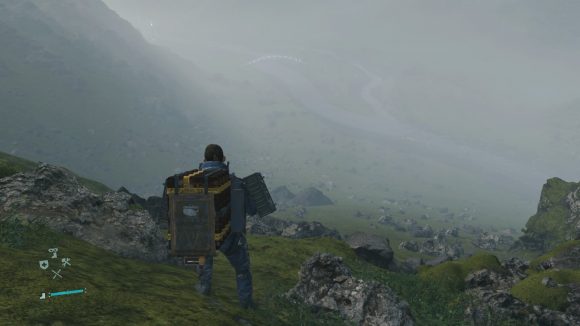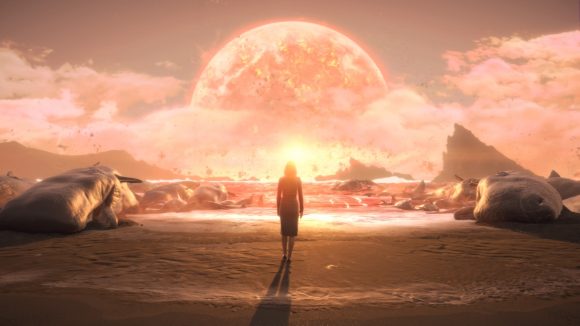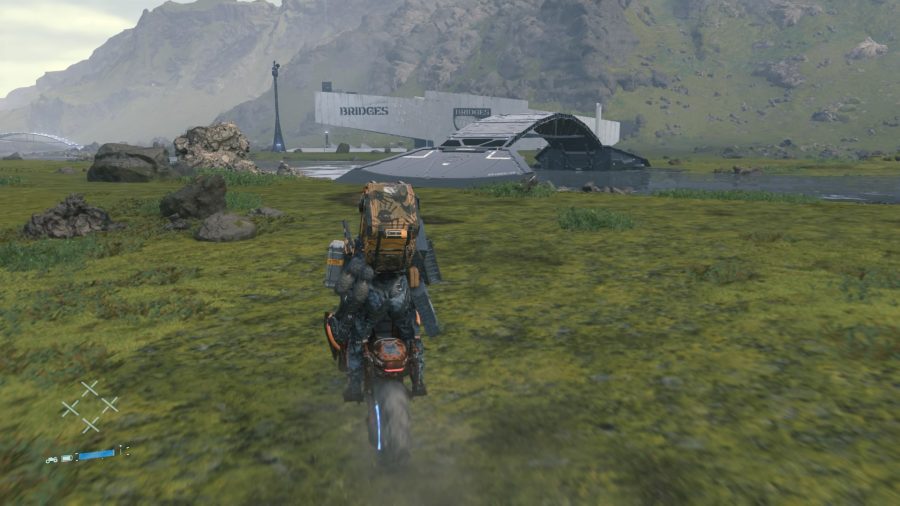Our Verdict
As thrilling as it is boring, as fantastic as it is mundane, but one thing’s for sure - there’s truly nothing else like it.
Hideo Kojima’s first post-Metal Gear videogame envisions a world in which people can’t leave their houses because of something deadly, which in 2020 obviously hits closer to home than he could’ve known. But the source of humanity’s demise isn’t a virus or its own hubris, it’s an invisible threat. You can’t fight what you can see, and so instead Death Stranding offers a solution hitherto unseen in big budget videogames – what if you didn’t shoot your enemies but simply walked around them?
It doesn’t sound enticing, and yet it’s an accurate description of Death Stranding, a game that can be achingly boring, but uses that boredom in such a way that even the most mundane problem becomes somehow exciting. You play as Sam Porter-Bridges (Norman Reedus), a, er, porter for a company called Bridges. Sam’s whole job is to deliver cargo on foot. Following an event called Death Stranding, the world of the living becomes connected to the afterlife via intermediary locations called beaches. You know, where things strand. The dead who get lost in the world of the living via beaches are thus called BTs, short for “beached things”. If a living being comes in contact with a BT, the result is a voidout, a massive explosion leaving nothing but a crater behind.
That’s not all – BTs appear during the rain, which isn’t simply rain, but ‘timefall’, rain that rapidly ages anything it comes into contact with. Understandably, this causes people to swiftly move underground, becoming dependent on porters the same way I now depend on the regular delivery of online orders. Sam can go outside because, unlike most people, he can sense BTs and thus find a way to avoid them. As if that wasn’t handy enough, he’s also a repatriate, meaning he can’t die.
Following the Death Stranding, people are doing their best to rebuild some sort of shared society via the UCA – “United Cities of America”. UCA cities exchange information with each other using the chiral network, Death Stranding’s post-apocalyptic internet. On her deathbed, Bridges, the president of the United States (played by Lindsay Wagner) asks Sam to travel to cities all across the USA and restore the network, all the way to the city his sister Amelie (also Wagner, digitally de-aged) is held in by separatists. It’s a very complicated setup for a simple idea – you stack cargo onto Sam’s back, you deliver it, at the point of delivery you pick up some more and walk to the next destination.
The delivery itself is likely the most enthralling thing about Death Stranding. It’s a game packed with pseudo-science and weird political ideas, making it unmistakable as a Kojima game, but it takes the simple act of walking and imbues it with so much detail that the journey itself, as lonely as it is, becomes the focus of the experience. Sam is just one man, with all the physical limitations that entails. If you burden him with too much cargo, he struggles with every step. His walking speed slows, he stumbles over the smallest stone, and if you take a hard turn the weight of his cargo causes him to lose balance. He can climb a few rocks, pushing himself up slowly, panting and grunting all the while, and he can wade through water shallow enough for him to stand in.
Difficult actions like this cost stamina and endurance. Stamina is the strength Sam can use short-term until a river drags him away or until holding his breath becomes too much, while his overall endurance depletes more slowly and is mostly measured by how tough the going gets. He can tread down his shoes until you need new ones. He needs to sleep and take showers to wash the grime off. Every tumble you take feels catastrophic – the last few seconds of desperate balancing before a hard impact, Sam swearing, his cargo taking damage and, most annoying of all, falling all over the place. Every stretch of the journey, across steep mountains and large rifts in the earth, takes patience and strength, and reaching a destination after a hard trek comes with the same sense of relief a real hike does.
Get about: How to unlock vehicles in Death Stranding
Sometimes you cross into BT territory, recognisable by an upside-down rainbow in the sky and particularly harsh timefall. While you eventually acquire weapons to deal with these ghosts, you’re generally encouraged to sneak your way through. To help with that, Sam acquires a BB, or bridge baby. Bridge babies are infants swimming in a tank of amniotic fluid, forever caught between life and the state of being unborn and thus able to sense BTs. The rain, your scanner constantly pinging for BTs, and the restless noises of your BB can make for pleasantly tense sneaking – even though compared to stealth sequences Kojima designed for Metal Gear, these never become really challenging.

Later in the game, you also encounter human enemies, from cargo-obsessed terrorists to the aforementioned separatists led by Higgs (Troy Baker), who you take down with more traditional methods. Firefights in Death Stranding are a disappointment: weapons feel entirely weightless; there’s no discernible difference to hit boxes; and often you’re in wide open space with no cover, which leaves no room for tactics. The occasional boss fight however, is exciting because all of the limitations placed on Sam still apply – he still carries cargo, gets out of breath, and needs to regain his footing. Balancing that with the very real threat of death can be a lot, and the battles are better for it.
Death Stranding doesn’t reinvent the wheel, it just puts a different spin on familiar gameplay elements such as the scanner or the zip line. There’s a book’s worth of tutorials for every piece of equipment, giant menus and controls that require so many buttons to be pressed simultaneously you’d do best to stick with the great mouse and keyboard controls. Both mechanically and narratively, the game sells itself as more complicated than it actually is – a large-scale fetch quest in which items don’t just disappear into the depths of your bottomless pockets. It’s a stimulating reappraisal of mechanics we’ve taken for granted for so long, but it unintentionally reinforces how some things, like fast travel, don’t just exist for convenience sake – they exist because their absence can turn a great game into a tedious one.
Making it to new landscapes serves as a good motivation, as Death Stranding looks fantastic. From snow-capped mountains to hills shrouded in mist, it offers great vistas, even if on ground level these often turn out to be craggy flatland. The core loop of finding a path and walking it is meditative and imbues you with a real sense of achievement all of its own even before you reach your destination. Unfortunately, you often walk the same paths back and forth in short succession, and the narrative justification for repeat trips is often flimsy at best. Had it left out these trips, Death Stranding could have been a good deal shorter. As it is, it even pads the whole experience with a collect-a-thon of additional, non-story-relevant orders.
For most of the game, the narrative takes a backseat to world-building in the form of emails and log entries. As much as Death Stranding hands to you in writing, as little do its characters actually say. Sam is near-silent, and most of the time only asks for more exposition. Conversations are full of pregnant pauses, and a lot of what’s being said simply presupposes information you don’t have. Additionally, some elements are left vague to the point of ridiculousness (“But why?” Sam asks in one scene, only to be told “You know why”).
The characters barely live up to such a description – not least Fragile (Leá Seydoux), the leader of Bridges competitor Fragile Express, who is more of a plot device/deus ex machina where needed. At the same time, Death Stranding somehow manages to make nearly all of its female characters the sole bearers of pain in its story, both physical and mental. If anything bad happens, it happens to a woman, and it happens in order to provide a vehicle to a male character’s actions. Good experiences and tender moments will be cancelled out by more horror down the line, so that the good you’re actually doing is an entirely invisible process. You hardly ever meet the people you make deliveries to, and the UCA is an anonymous mass of Americans you have no connection to. Your efforts are regularly rewarded with the same cheer of positive reinforcement: “Well done, Sam!”, “You’re the best, Sam!”, “We’d all be lost without you, Sam!”
This is especially odd seeing as Death Stranding otherwise makes such an effort to somehow bake all of its conventional gamey-ness into its world-building. Take the multiplayer element and Likes, the game’s currency. On your journey, you often depend on other players – real players and NPCs you never get to see, as you help each other by building bridges and shelters everyone can use. You can press a button to call out for them as you would a person, and they will answer, making things less lonely for a moment. It’s a fascinating idea for a multiplayer element in an otherwise single-player game, it works well and is often sorely needed.
You can give Likes to other players, earn them by building things, and of course get them for deliveries. Likes work as experience points, only that they don’t upgrade your character, but cities and waystations instead, making it possible to gain better equipment there. NPCs will regularly speak of those other porters, and in several scenes award you Likes. It’s all very meta, making connections between other people and using social media currency, but it’s delivered with absolute seriousness.
Hike even further: The best open-world games on PC
For all intents and purposes, Death Stranding is often a fairly conventional game behind the veneer of an artistic fever dream. A giant vanity project that fits in cameos by characters from Valve games, but it’s the seriousness with which it delivers even its most ridiculous ideas that makes it work. I wanted to see it all – the next gizmo that would help me on my travels, the next cutscene full of beautiful digital people with flawless skin (and Guillermo del Toro as Bridges resident boffin), the next vaguely creepy vision of the afterlife. Death Stranding can try to sell you merchandise and Monster energy drinks one moment, and ponder about the value of human life the next.
Kojima’s muses and famous friends act out a story so overblown there’s no point in asking after its flimsy politics or trying to fill its plot holes – as always with him, either you’re on board or you’re off. This time, I was firmly on, and it wasn’t for the story, it was for this weird, thrilling, and sometimes deeply boring experience. The mere fact that the game managed to be all these things at once made me respect it, as little as I cared for its story or bland world. In the end, the journey was the destination.
































